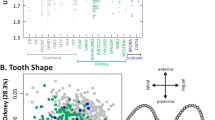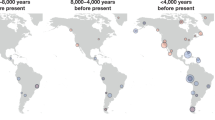Abstract
Madeira is a small volcanic island in the Atlantic Ocean with steep mountains separating narrow valleys that are the only areas habitable by humans and their commensals. Here we show that house mice (Mus musculus domesticus ) on Madeira have an unexpected chromosomal diversity, the evolution of which is independent of adaptive processes, relying instead on geographic isolation and genetic drift.
Similar content being viewed by others
Main
The evolution of animal species living on islands has given rise to spectacular examples of adaptive radiation in response to new physical and biotic environments1,2. Natural selection is the main mechanism responsible for shaping these radiations, leading to accelerated rates of speciation, but non-adaptive processes may also play a part1,3. We suggest that the extreme topography of Madeira has restricted the movement of mouse populations between valleys, setting the stage for extensive chromosomal radiation.
We found six distinct chromosomal races of the house mouse on Madeira, separated from each other by mountain barriers (Fig. 1). The races have severely reduced diploid numbers relative to the standard for the species (2N=40) owing to the presence of numerous robertsonian chromosomal fusions4, each of which results from the joining of a pair of the standard chromosomes. These fusions have been recorded in wild house mice4, but the six races on Madeira that carry robertsonian fusions differ from each other and from races elsewhere as a result of the particular combinations of fusions that characterize them ( Fig. 2).
Of the 20 robertsonian (Rb) fusions observed, 13 have not previously been recorded. The presence of two fusions involving chromosome 19 is exceptional: they are the first observed in 91 fusions in wild house mice4,9. Diploid numbers (N) and sample sizes (n) with ranges are as follows: red dot, 2N=22, n=43 (1–21); red rectangle, 2 N=23–24, n=5 (1–2); red star, 2N=24–40, n=38 (2–19); yellow dot, 2N=28–30, n=5 (1–4); blue dot, 2N=25–27, n=10 (2–8); white dot, 2 N=24–26, n=11 (1–4); green dot, 2N=24–27, n=25 (1–7); black dot, 2N=24, n=6.
House mice are thought to have been introduced onto Madeira following the first Portuguese settlement during the fifteenth century, although fourteenth-century charts indicate that the island was known about before then5. The extent of their chromosomal differentiation indicates that populations of house mice were isolated in different valleys for long enough to allow fusions to accumulate. Because each successive fusion as it appears is associated with only a slight underdominance4, its fixation can most parsimoniously be explained by population processes such as genetic drift, as inferred for other chromosomal races of house mice6.
This example of chromosomal variation among mice on Madeira suggests that human movements were similarly restricted, limiting the passive migration of commensal house mice between valleys. So far, not a single hybrid has been recorded between races carrying robertsonian fusions among the 143 mice that we have karyotyped. We found extensive chromosomal heterozygosity in Funchal, however, probably because of the recent immigration of standard diploid mice through the commercial port.
Hybrids between any of the Madeiran mouse races carrying robertsonian fusions would be sterile or infertile owing to the complex chromosomal configurations that would be produced at meiosis7,8. Our results indicate not only that accelerated rates of radiation can occur without involving adaptive processes, but also that chromosomal evolution can be an efficient mechanism of isolation, as several reproductively isolated chromosomal races have appeared in less than 500 years.
References
Grant, P. R. (ed.) Evolution on Islands (Oxford Univ. Press, 1998).
Losos, J. B., Jackman, T. R., Larson, A., de Queiroz, K. & Rodriguez-Schettino, L. Science 279, 2115–2118 (1998).
Provine, W. B. in Genetics, Speciation, and the Founder Principle (eds Giddings, L. V., Kaneshiro, K. Y. & Anderson, W. W.) 43–76 (Oxford Univ. Press, New York, 1989).
Nachman, M. W. & Searle, J. B. Trends Ecol. Evol. 10, 397–402 (1995).
Mathias, M. L. & Mira, A. Biol. J. Linn. Soc. 46, 13–24 (1992).
Hauffe, H. C. & Searle, J. B. Evolution 47, 1374–1395 (1993).
Baker, R. J. & Bickham, J. W. Proc. Natl Acad. Sci. USA 83, 8245–8248 (1986).
Hauffe, H. C. & Searle, J. B. Genetics 150, 1143–1154 (1998).
Garagna, S., Zuccotti, M., Redi, C. A. & Capanna, E. Nature 390, 242 (1997).
Author information
Authors and Affiliations
Corresponding author
Rights and permissions
About this article
Cite this article
Britton-Davidian, J., Catalan, J., da Graça Ramalhinho, M. et al. Rapid chromosomal evolution in island mice. Nature 403, 158 (2000). https://doi.org/10.1038/35003116
Issue Date:
DOI: https://doi.org/10.1038/35003116
This article is cited by
-
Population structure and inbreeding in wild house mice (Mus musculus) at different geographic scales
Heredity (2022)
-
Multiple independent chromosomal fusions accompanied the radiation of the Antarctic teleost genus Trematomus (Notothenioidei:Nototheniidae)
BMC Evolutionary Biology (2020)
-
Chromoanagenesis: a piece of the macroevolution scenario
Molecular Cytogenetics (2020)
-
Chromoanagenesis: cataclysms behind complex chromosomal rearrangements
Molecular Cytogenetics (2019)
-
Chromothripsis, a credible chromosomal mechanism in evolutionary process
Chromosoma (2019)
Comments
By submitting a comment you agree to abide by our Terms and Community Guidelines. If you find something abusive or that does not comply with our terms or guidelines please flag it as inappropriate.





